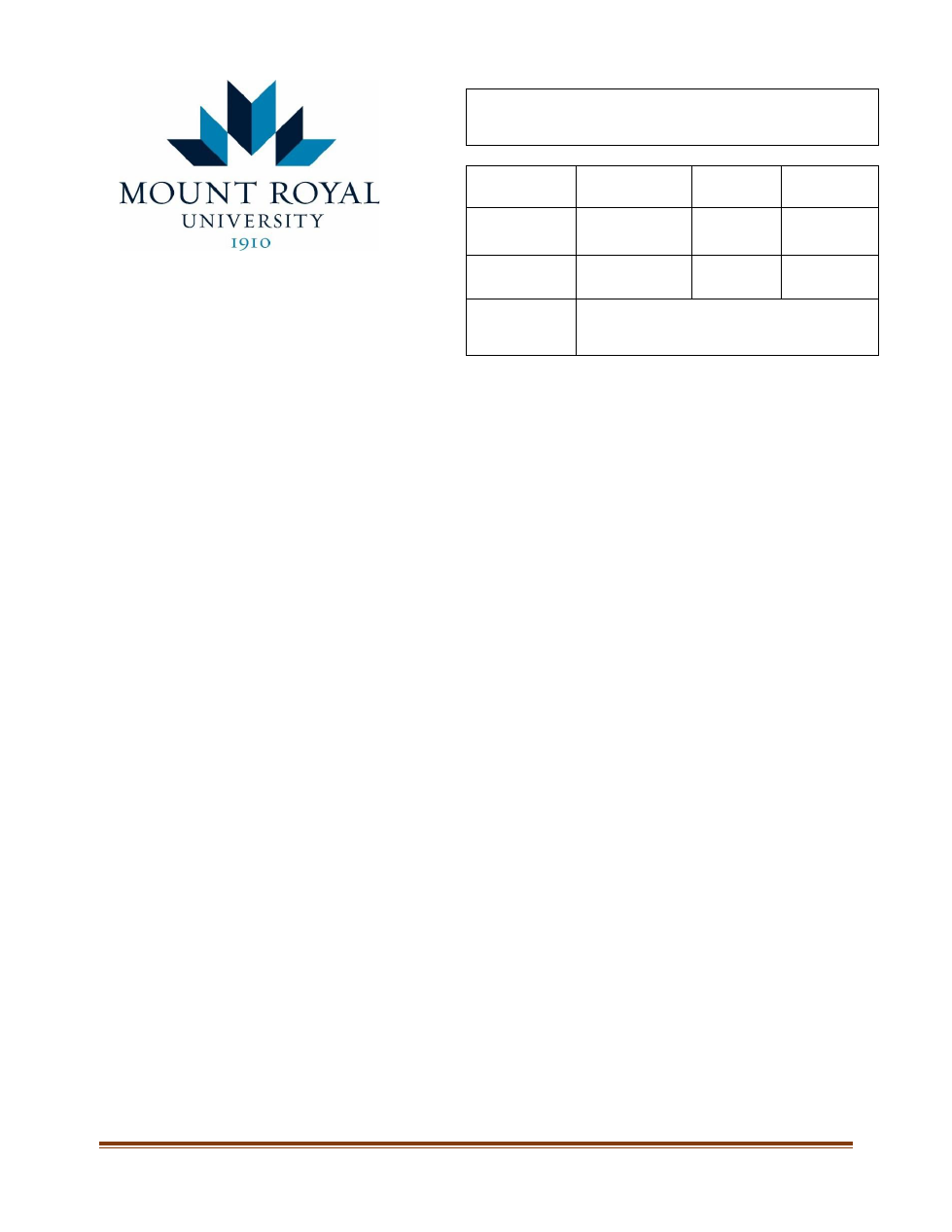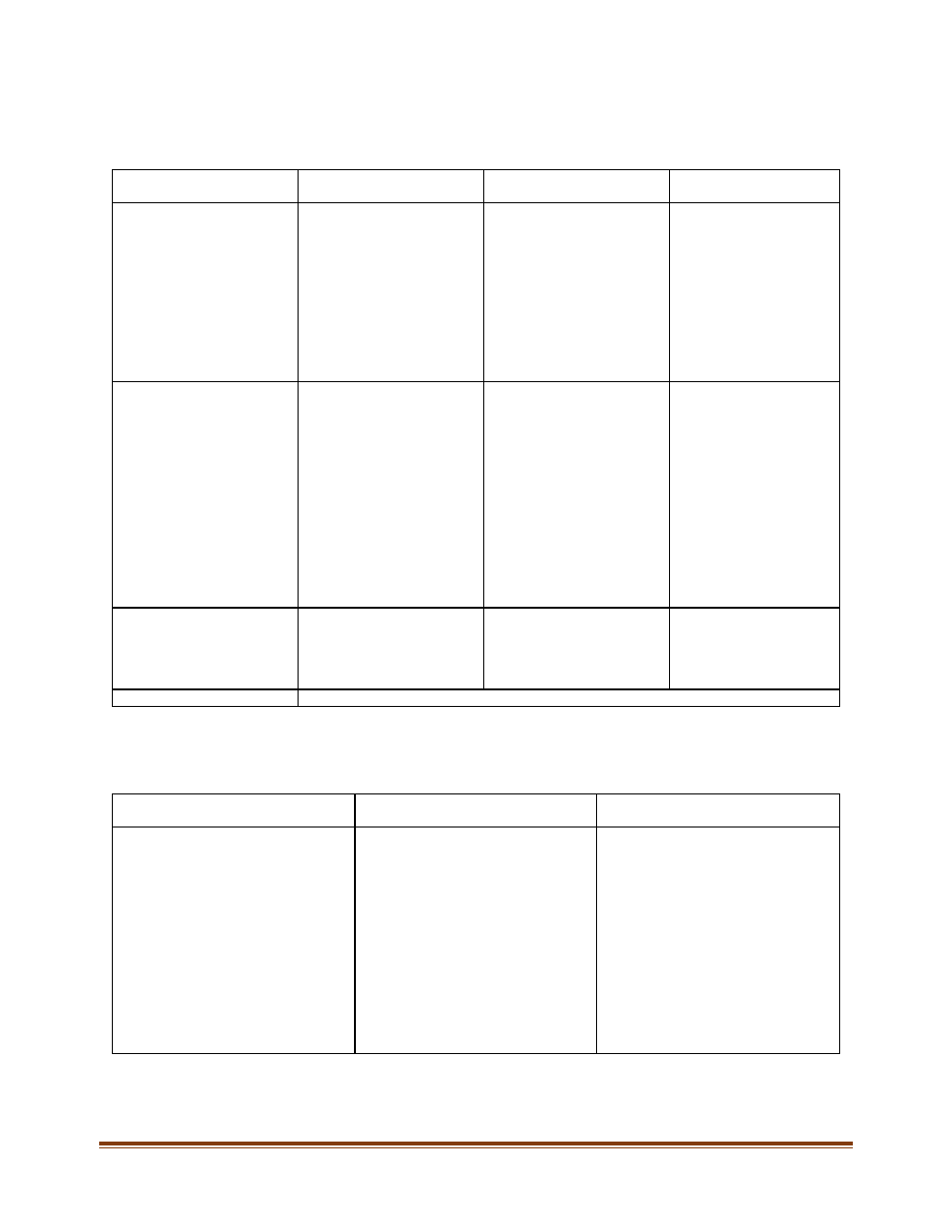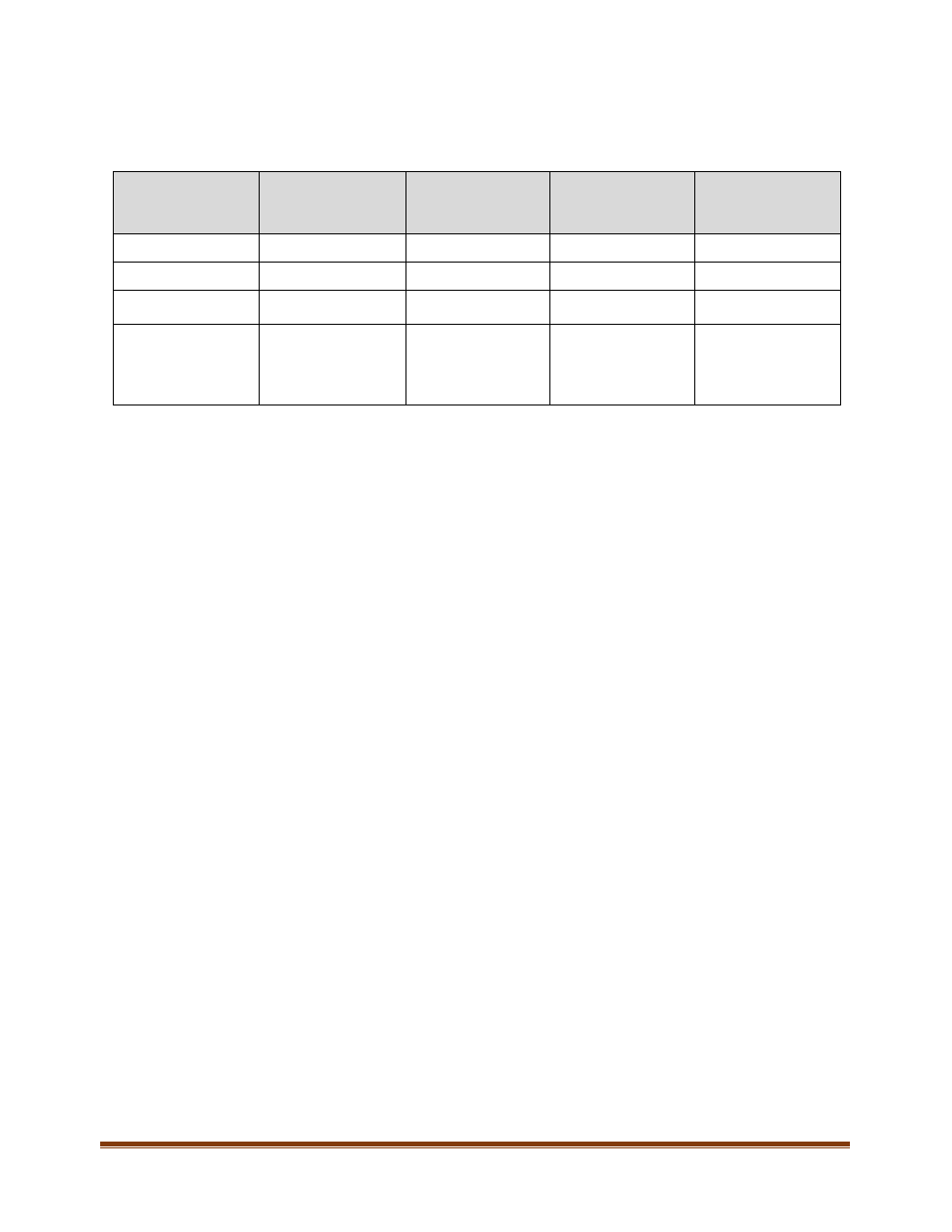
This version of the policy goes into effect October 1, 2024
Admission Policy – April 19, 2024
Page 1 of 17
A.
PURPOSE
This Policy governs the Admission process, categories, conditions and requirements.
B.
SCOPE
This Policy applies to all credit programs and all prospective students applying for admission into
a credit program.
C.
POLICY STATEMENT
1.
ADMISSION TO MINISTERIALLY-APPROVED PROGRAMS
1.1
To ensure adequate academic preparation, the University has established
standards and criteria for admission. These standards and criteria are based on the
following principles:
a. Admission criteria need to be clear and objective.
b. Competitive Admission will be used to rank applicants within the Admission
Categories referenced in 2.0.
c. All Admission Categories referenced in 2.0, will be considered equal in making
admission decisions.
d. For some programs, applicants may be required to participate in the
Assessment of Non-academic Criteria.
e. Applicants must satisfy all criteria for Final Admission.
f. Admission is only valid for the semester indicated on the admission offer letter.
g. Standards and criteria for admission to certificate, occupational, academic
upgrading and other ministerially-approved non-credit options may be
established at the program level and can vary from the University standards
and criteria for admission
ADMISSION POLICY
Policy Type:
Academic
Initially
Approved:
September
2015
Policy
Sponsor:
Provost & VP
Academic
Last
Revised:
April 19, 2024
Administrative
Responsibility:
AVP, Enrolment
Management &
Registrar
Review
Scheduled:
April 19, 2029
Approver:
General Faculties Council

This version of the policy goes into effect October 1, 2024
Admission Policy – April 19, 2024
Page 2 of 17
1.2
General Conditions
a. Equivalent post-secondary courses may be substituted for required high school
Subjects.
b. Two courses from the same Subject cannot be used for the purpose of
admission unless otherwise stated in 5.2.
c. A minimum of 60% is required in English Language Arts 30-1 for all degree
programs unless a higher grade is approved at the program level.
d. Admission Requirements must be consistent across all Admission Categories
for a single program.
e. Admission Requirements must be consistent across all majors within a
program unless an evidence-based reason supports different requirements.
f. The criteria for determining which courses are required for admission to a
program/major are:
i.
course serves as a prerequisite for a required course(s) within the
program;
ii.
competitor analysis (common course requirement for same field of study
at other universities);
iii.
other evidence-based research to show the course is critical to student
success; or
iv.
course is required to meet criteria of professional associations, approval
bodies, or other external accreditation bodies.
g. When an applicant presents the same course with more than one grade (i.e.,
the course has been repeated), the higher grade shall be used for evaluating
admissibility.
h. For programs with Competitive Admission, Early Admission applicants will be
considered equally regardless of the timing of receipt of application during this
period.
i. For programs with Non-competitive Admission, Early Admission applicants will
be considered on a first come, first-served basis. Appropriate tie breaking
criteria may be required.
j. Post-secondary courses used for admission to a program may also be applied
to program graduation requirements, depending on the applicability of the
courses to the curriculum, the standard of performance achieved, and time
limits of the program.
k. The primary language of instruction and communication at the University is
English. All applicants in undergraduate credit programs, Non-credential
Offerings, occupational programs and academic upgrading for whom English is
not their first language must demonstrate proficiency in English.
l. When an applicant presents a Letter of Permission from an accredited post-
secondary institution, this will serve as their sole basis of admission. They will
not be required to demonstrate proficiency in English, provide transcripts or

This version of the policy goes into effect October 1, 2024
Admission Policy – April 19, 2024
Page 3 of 17
meet the course pre-requisites.
2.0 ADMISSION CATEGORIES
2.1
High School – Applicants will be considered on the basis of High School if:
a. applicant is currently in high school, has left high school, or has completed high
school; and
b. applicant has not completed sufficient post-secondary courses to be
considered in the Post-secondary category.
2.2
Post-secondary – Applicants will be considered on the basis of Post-secondary if:
a. applicant has completed four (4) post-secondary courses (minimum 12 credit
hours) by December 31; and will have completed eight (8) post-secondary
courses (minimum 24 credit hours) by June 30 for admission to the Fall
semester; or
b. applicant will have completed eight (8) post-secondary courses (minimum 24
credit hours) by August 31 for admission to the Winter semester.
2.3
Mature – Applicants will be considered on the basis of mature standing if:
a. applicant does not meet the Admission Requirements associated with the High
School Admission Category as referenced in 5.0;
b. applicant has not completed sufficient courses to be considered in the Post-
secondary category; and
c. applicant is 21 years of age by September 1 for the Fall semester OR January
1 for Winter semester admission.
3.0 ADMISSION TO NON-CREDENTIAL OFFERINGS
Unless otherwise indicated in 3.0, Non-credential Offerings fall outside of the Admission
Categories referenced in 2.0.
3.1
Open Studies
a. Non-competitive Admission.
b. Applicants are not required to meet specific course and grade requirements.
3.2
University Entrance Option
a. Competitive Admission.
b. Applicants are required to meet specific course and grade requirements.
c. Applicants who have completed four (4) or more post-secondary courses by
December 31 for Fall semester or August 31 for Winter semester are not
eligible to apply for admission: therefore, applicants will be considered under
the high school and mature Admission Categories only.
3.3 Admission to a degree/diploma program for University Entrance Option students.
To be eligible for admission to a degree/diploma program, University Entrance
Option students must:

This version of the policy goes into effect October 1, 2024
Admission Policy – April 19, 2024
Page 4 of 17
a. Apply during Early Admission.
b. Meet specific course and grade requirements.
c. Meet Non-academic Criteria (where required).
d. Meet the Competitive Admission Average.
i.
The Competitive Admission Average will be based on the four (4) most
recently completed post-secondary courses (minimum 12 credit hours)
by December 31. Applicants will be required to meet the Competitive
Admission Grade Point Average (GPA) of the previous year or reduced
GPA for specific programs as determined on an annual basis, not to
exceed .3 reduction in GPA from the previous year.
OR
ii.
The Competitive Admission Average will be based on the four (4) most
recently completed post-secondary courses (minimum 12 credit hours)
by April 30. Applicants will be required to meet the Competitive
Admission Average (GPA) of the previous year for the specific program.
d. Meet the Final Admission criteria.
i.
Final Admission will be based on verification of admissibility once all final,
official transcripts, including all previous high school and post-secondary
coursework, have been received and reviewed and all conditions of the
applicant’s admission have been met. Unless a specific (higher)
admission average is required, applicants are required to have a
minimum of 2.00 Grade Point Average (GPA) on a minimum of four (4)
most recently completed post-secondary courses (minimum 12 credit
hours) up to a maximum of eight (8) most recently completed post-
secondary courses (maximum 24 credit hours) whichever is greater by
June 30 for the Fall Semester. Official transcripts must include final
grades for all Subjects required by the program of study and be received
by August 1 for admission to the Fall Semester.
3.4
University Entrance Option (UEO) International Pathway
a. International applicants may be evaluated for the International Pathway if one
or more of the following requirements for their intended degree/diploma
program has not been met:
i.
Competitive Admission Average.
ii. Specific course or grade requirements.
iii. English Language Proficiency requirement (Institutional) as referenced in
10.0.
b. International Applicants must:
i. Reside and apply from outside of Canada.
ii.
Have not previously attended any post-secondary institution.

This version of the policy goes into effect October 1, 2024
Admission Policy – April 19, 2024
Page 5 of 17
iii. Meet the requirements for the University Entrance Option as referenced
in 3.2.
iv. Meet the English Language Proficiency requirement (International
Pathway) as referenced in 11.0.
c. Upon entry to the UEO International Pathway, applicants who meet the
Competitive Admission Average for their intended degree/diploma program
may be granted Conditional Admission to that degree/diploma program for a
future semester.
d. UEO International Pathway students, who were not previously granted
Conditional Admission to their intended degree/diploma program, as
referenced in 3.4(c), may apply for admission to their intended degree/diploma
program within the stated timelines for their intended semester and must meet
the following criteria:
i.
Competitive Admission Average;
ii.
Specific course and grade requirements; and
iii.
Non-academic Criteria (where required).
e. Final Admission
i. Verification of admissibility once final, official transcripts, including all
previous high school and post-secondary coursework have been received
and reviewed and all conditions have been met. Unless a specific (higher)
admission average is required, applicants are required to have a minimum
of 2.00 Grade Point Average (GPA) on a minimum of two (2) and a
maximum of four (4) of their most recently completed post- secondary
courses (12 credit hours) by June 30 for the Fall Semester. Official
transcripts must include final grades for all Subjects required by the
program of study and be received by August 1.
ii.
English Language Proficiency requirement (Institutional).
ADMISSION DEFERRAL
4.1
Applicants offered admission into an undergraduate credit program may request a
deferral for up to one year. Applicants can submit one deferral request per
application cycle and may not seek additional deferrals if they are unable to attend
in the semester to which they have been deferred. To be eligible for consideration
for a deferral, the applicant must:
a. Accept the admission offer and pay the tuition deposit.
b. Meet Final Admission criteria for the initial admission offer.
c. Meet any Admission Requirements that may have been implemented for the
new semester of admission.
d. Submit the Request for Admission Deferral Form by August 15 for the Fall
semester or December 15 for the Winter semester outlining the reasons for

This version of the policy goes into effect October 1, 2024
Admission Policy – April 19, 2024
Page 6 of 17
the request and including appropriate supporting documentation such as.
i. a doctor’s letter that explicitly states that a physical or psychological
condition make it impossible for the applicant to attend the University for
the specified time period;
ii.
proof of participating in an exchange or volunteer program with clear
timelines; or
iii. proof of study permit delay (but not denial) including proof of timely
submission of a completed application for a study permit to study in
Canada.
4.2
Requests for deferral will be reviewed by the Director of Admissions and
Recruitment and the Dean, or designate, of the Faculty responsible for the program
(where space limitations exist).
a.
Restrictions on Admission Deferrals
i. If the admission deferral is approved, the applicant may not attend any
high school or post-secondary institution during the period of the deferred
admission. Applicants who attend a high school or post-secondary
institution during this time will have their request for deferred admission
withdrawn and may submit a new application for admission evaluation.
ii.
The University has the right to refuse any request.
iii. There is no appeal process.

This version of the policy goes into effect October 1, 2024
Admission Policy – April 19, 2024
Page 7 of 17
5.0 ADMISSION REQUIREMENTS
5.1
High School Course Requirements for Admission Categories and Non-credential
Offerings
High School
Admission Category
Post-secondary
Admission Category
Mature
Admission Category
Degree Programs*
Specific courses required
by the program must be
included in the five
Subjects below:
1) English Language Arts
30-1
2) Group A course
3) Group A course
4) Group A or B course
5) Group A, B, or C
Specific high school courses
required by the program
must be presented for
admission.
No additional Group A, B, or
C Subjects required.
Specific courses required
by the program must be
presented for admission.
1) English Language
Arts 30-1
2) Group A course
Diploma Programs
Specific courses required
by the program must be
included in the five
Subjects below:
1) English Language Arts
30-1
2) Group A course
3) Group A, B, or C
course
4) Group A, B, or C
course
5) Group A, B, or C
course
Specific high school courses
required by the program
must be presented for
admission.
No additional Group A, B, or
C Subjects required.
Specific courses required
by the program must be
presented for admission.
1) English Language
Arts 30-1
2) Group A course
University Entrance
Option
1) Group A course
2) Group A course
3) Group A course
4) Group A or B course
5) Group A, B, or C course
1) Group A course
2) Group A course
Open Studies
No specific course or grade requirements.
*Criteria for admission to degree programs through a post-diploma intake may be established at the program level
and can vary from the criteria for degree programs.
5.2
Group A, B and C Courses
Group A
Group B*
(must be 5 credit)
Group C
English Language Arts 30-1
Mathematics 30-1 (or Mathematics
30-2 if accepted by the program)
Mathematics 31
Biology 30
Chemistry 30
CTS Computing Science 30 level*
Physics 30
Science 30
Aboriginal Studies 30*
Social Studies 30-1
French 30, 31, French Language Arts
30, Francais 30
All other languages 30
Art 30 or 31
Drama 30
Music 30 (choral, instrumental,
general)
Physical Education 30
Religious Studies 35
Social Studies 30-2
Other five-credit Grade 12 Subjects
or a combination of two three-credit
Grade 12 Subjects
Five credits of advanced career and
technology courses
Note -- Special Projects cannot be
used for admission
A same subject area course may be
used as a Group C course for the
purpose of final admission average
calculation
*some of these courses can be taken as 1- to 5-credit courses – they can only be used if they are 5 credits
Note: Aboriginal Studies 30 (5-credit) may be used in lieu of Social Studies 30 – 1.

This version of the policy goes into effect October 1, 2024
Admission Policy – April 19, 2024
Page 8 of 17
5.3
High School Admission Category
a. Applicants applying for admission on the basis of High School Standing must
present the five appropriate Grade 12 subjects (or their equivalents), with no
grade below 50%.
b. Conditional Admission
i.
The Competitive Admission Average will be calculated on the two
highest self-reported or final grades from the list of Grade 12 Subjects in
Group A.
ii.
Verification of self-reported grades may be required.
c. Final Admission
i.
Final Admission for this Admission Category will be based on verification
of admissibility once final, official transcripts, including all previous high
school and post-secondary coursework has been received and reviewed
and all conditions of the applicant’s admission have been met.
ii.
Unless a specific (higher) admission average is required, high school
applicants are normally required to have an overall admission average of
65% for degree programs and 60% for diploma and appropriate Non-
credential Offering on five appropriate Grade 12 Subjects and remain in
good academic standing if they are currently enrolled in any post-
secondary coursework. The 65% admission threshold may be lowered to
60% if required to meet an admission intake target.
iii.
Official transcripts must include final grades for all Subjects required by
the program of study and be received by August 1 for admission to the
Fall semester or December 1 for admission to the Winter semester.
5.3 Post-secondary Admission Category
a. Courses presented for admission must be from a recognized post-secondary
institution and must be transferable courses as determined by the University.
b. Conditional Admission
i.
The Competitive Admission Average will be calculated on the four (4)
most recently completed courses (minimum 12 credit hours) by
December 31 for the Fall semester or the eight (8) most recently
completed courses (minimum of 24 credit hours) by August 31 for the
Winter semester.
ii.
Final/official transcripts showing all post-secondary courses completed
by these dates are required to be considered for Conditional Admission.
c. Final Admission
i.
Final Admission for this Admission Category will be based on verification
of admissibility once final, official transcripts, including all previous high
school and post-secondary coursework have been received and reviewed
and all conditions of the applicant’s admission have been met.
ii.
Unless a specific (higher) admission average is required, post-secondary
applicants are required to have a minimum of 2.00 Grade Point Average

This version of the policy goes into effect October 1, 2024
Admission Policy – April 19, 2024
Page 9 of 17
(GPA) on their eight (8) most recently completed post-secondary courses
(minimum 24 credit hours) by June 30 for the Fall semester or August 31
for the Winter semester.
iii.
In instances where an applicant cannot present final letter grades on their
eight (8) most recently completed post-secondary courses due to the
awarding of aegrotat or equivalent grades, final admission calculation will
be calculated on a minimum of four (4) post-secondary courses.
Applicants who present fewer than four (4) completed post-secondary
courses will be evaluated under the high school or mature admission
category.
iv.
Official transcripts must include final grades for all Subjects required by
the program of study and be received by August 1 for admission to the
Fall semester or by December 1 for admission to the Winter semester.
5.4
Mature Admission Category
a. Conditional Admission
i.
The Competitive Admission Average will be calculated on the two
highest final grades from the list of appropriate Grade 12 Subjects from
Group A.
b. Final Admission
i.
Final Admission for this category will be based on verification of
admissibility once final, official transcripts, including all previous high
school and post-secondary coursework, have been received and
reviewed and all conditions of the applicant’s admission have been met.
ii.
Mature applicants are required to remain in good academic standing if
they are currently enrolled in any post-secondary coursework.
iii.
Official transcripts must include final grades for all Subjects required by
the program of study and be received by August 1 for admission to the
Fall semester or by December 1 for admission to Winter semester.
5.5
Alternatives to Regular Course Credit
a. Advanced Placement (AP)
i.
In the context of this policy, AP courses are those offered at the high
school level and developed by The College Board, New York.
ii.
Applicants who successfully complete Advanced Placement (AP)
courses may use applicable AP courses for the purposes of admission
and/or transfer credit.
iii.
Where transfer credit is awarded, the course will be used towards the
calculation of the admission GPA within the post-secondary admission
category.
iv.
Applicants who complete both Advanced Placement courses and high
school courses, will be assessed on the grades which are most
advantageous for the student within the high school admission category.

This version of the policy goes into effect October 1, 2024
Admission Policy – April 19, 2024
Page 10 of 17
b. International Baccalaureate (IB)
i.
In the context of this policy, IB courses are those offered at the high
school level and developed by the International Baccalaureate
Organization, Geneva.
ii.
Applicants who successfully complete International Baccalaureate (IB)
courses may use applicable IB courses for the purposes of admission
and/or transfer credit.
iii.
Where transfer credit is awarded, the course will be used towards the
calculation of the admission GPA within the post-secondary category.
iv.
Applicants who complete both International Baccalaureate courses and
high school courses, will be assessed on the grades which are most
advantageous for the student within the high school admission category.
c. Home School
i.
Home schooled applicants who present recognized secondary
credentials will be considered for admission to the University.
6.0 USE OF ASSESSMENT OF NON-ACADEMIC CRITERIA FOR ADMISSION TO
SPECIFIC PROGRAMS
6.1
For most programs, quantifiable academic criteria established for each category of
admission, together with the specific course requirements and admission averages,
constitute an adequate basis for evaluating admissibility.
6.2
General Faculties Council may approve Non-academic Criteria for selection of
students in specific programs provided that General Faculties Council is satisfied
that the program(s) in question has met at least one of the following conditions:
a. it is demonstrated that the information so gained is essential to ensuring the
likelihood of students' success in the program; or
b. it is demonstrated that the information so gained is a valid and reliable indicator
of success in the program; or
c. it is demonstrated that such Non-academic Criteria is required for program
accreditation.
6.3
The following criteria must also be met:
a. it is demonstrated that the information so gained will be obtained in the most
efficient and effective way possible; and
b. it is demonstrated that the use of such Non-academic Criteria will allow for
decisions regarding the admission and selection of students for the program to
be made in a timely manner.
7.0 RE-ADMISSION
7.1
Re-Admission to the University
a. Students are permitted to interrupt their studies for a maximum of six
consecutive semesters (including the Spring and Summer semesters) and
return to the same program of study. Students who have interrupted their

This version of the policy goes into effect October 1, 2024
Admission Policy – April 19, 2024
Page 11 of 17
studies for a longer period of time and wish to return must apply for admission
to a semester that has an intake for their program (normally Fall Semester),
complete the application procedures in accordance with the application
timelines, pay the non-refundable application processing fee, and be admitted
upon each return. To qualify for graduation status, re-admitted students must
fulfill the graduation requirements in effect at the time of their re-admission.
7.2
Re-Admission Following an Interruption of Program of Studies
a. Students who have interrupted their program for longer than the allowable
period as described in 7.1 (a) and wish to return to the same program will be
required to reapply for admission and meet the current admission requirements
in place for that program but will not be required to meet the Competitive
Admission Average if:
i.
they apply during Early Admission;
ii.
there is space available in the program to which they are seeking re-
admission; and
iii.
they have not taken courses outside of their program at the University or
attended another post-secondary institution in the interim.
b. A student re-admitted to the program is governed by the program requirements
in effect at the time of the most recent admission.
7.3
Re-Admission to the University following a Requirement to Withdraw
a. A student who has been Required to Withdraw from the University, or any
other post-secondary institution, will not be admitted to the University until at
least a twelve (12) month period has elapsed since the student was Required
to Withdraw.
b. Applicants who have been Required to Withdraw from the University or another
post-secondary institution for academic reasons may be considered for
admission to their intended program of study, either on the basis of high school
standing or mature standing, after at least a twelve (12) month period has
elapsed unless they have completed four (4) additional post-secondary courses
by December 31 for admission to the following Fall semester or by August 31 to
the following Winter semester.
c. A student may register in non-credit academic upgrading courses during the
twelve (12) month waiting period.
d. Students who have been Required to Withdraw must apply for re-admission in
accordance with re-admission procedures.
7.4
Re-Admission following a Required to Withdraw from a Specific Program
a. A student who has been Required to Withdraw from a specific program at the
University, will not be re-admitted to that same program until at least a twelve
(12) month period has elapsed since the student was Required to Withdraw.
b. A student will only be considered for re-admission to the same program where
program requirements allow it.
c. A student who has been Required to Withdraw from a specific program at the
University or another post-secondary institution may apply and be considered

This version of the policy goes into effect October 1, 2024
Admission Policy – April 19, 2024
Page 12 of 17
for another program at the University without serving the twelve (12) month
waiting period.
d. A student applying for admission under these circumstances will be considered
for admission under the same Admission Categories as other applicants.
8.0 APPEALS
8.1
Students who have not been offered admission can request that the Dean or
designate consider an Exceptional Admission. There is no appeal of the decision.
9.0 UNDER-REPRESENTED AND SPECIAL POPULATIONS
9.1
Admission of Indigenous Applicants
a. Indigenous applicants may be admitted under two admission routes.
b. Indigenous applicants will qualify under the general admission route if they
meet all Admission Requirements and the Competitive Admission Average for
the specific program.
c. Indigenous applicants may qualify under the special consideration for
designated seats, through a program-specific Indigenous admission target, if
they meet:
i.
the definition of an Indigenous applicant; and
ii.
the minimum Admission Requirements as indicated in the general
admission requirements for the University, as well as any program level
admission requirements.
d. Designated seats, through program-specific Indigenous admission target, will
be held until July 15 for the Fall semester, at which time they will become
available for other applicants.
9.2
Admission of Student Athletes
a. A maximum of 30 seats may be designated for recruited athletes in University
Entrance Option.
b. A maximum of 30 seats may be designated for recruited athletes in Open
Studies.
c. The designated seats will be held until July 15 for the Fall semester and
December 1 for the Winter semester each year at which time they will become
available for other applicants.
d. Athletes applying for these seats must meet all general and Competitive
Admission Average requirements for University Entrance Option or Open
Studies.
9.3
International Students (Study Permit Applicants)
a. There are two categories of International applicants:
i.
Applicants residing and applying from outside Canada. This type of
applicant is normally accepted for the Fall semester only.

This version of the policy goes into effect October 1, 2024
Admission Policy – April 19, 2024
Page 13 of 17
ii.
Applicants presently studying in Canada at the University or another
institution. Applicants who entered Canada on a Study Permit to attend
another educational institution must complete at least one semester at
that institution before their application for admission to the University will
be considered. This type of applicant may be considered for admission to
the Fall semester or the Winter semester.
b. For applicants applying from outside of Canada with the exception of citizens
of the United States, the application for admission and all supporting
documentation including final, official high school and post-secondary
transcripts and evidence of meeting the English Language Proficiency
(Institutional) requirement, must be submitted in accordance with the deadlines
for International applicants. These deadlines may change from year to year
depending on internal or external circumstances.
c. International applicants residing and applying from outside Canada who enter
the University’s Academic English program may be granted Conditional
Admission for a degree, diploma or Open Studies (eighteen to twenty-four (18-
24) months in advance of a Fall semester) at the same time they are accepted
into the Academic English program, provided they demonstrate competitive
admission average where required. Final Admission to a future program will be
dependent on the student achieving the required level of English Language
Proficiency (Institutional), as referenced in 10.0 and satisfying admission
criteria as set by the program.
10.0 ENGLISH LANGUAGE PROFICIENCY REQUIREMENT (ELP) INSTITUTIONAL ENTRY
10.1
All applicants for whom English is not their First Language must satisfy two
separate and distinct English requirements for admission to the University:
a. Applicants must demonstrate proficiency in English in the areas of
reading, writing, listening and speaking; and
b. Applicants must have successfully completed the English course required for
admission to their intended program of study (or equivalent).
10.2
An applicant can demonstrate English language proficiency for the purposes
of admission in one of the following ways:
a. successful completion of the equivalent of two (2) years of full-time study
(minimum three courses per semester excluding English as an Additional
Language courses) in an English language secondary or post-secondary
institution or a combination of the two. Study must have been in an English
speaking country as recognized by the University and include the successful
completion of English Language Arts 30 – 1, English Language Arts 30-2,,or
equivalents.
b. successful completion (with a grade of B- [80%] or better) of Academic English
(LEAP 4 Advanced) taken at the University.
c. presentation of an official Test of English as a Foreign Language iBT (TOEFL)
score with the institutionally approved minimum score.
d. presentation of the International English Language Test (Academic IELTS,
including Academic Online) with the institutionally approved minimum score.
e. presentation of the Canadian Academic English Language Assessment (CAEL)
with the institutionally approved minimum score.

This version of the policy goes into effect October 1, 2024
Admission Policy – April 19, 2024
Page 14 of 17
f. presentation of the MET (Michigan English Test) with the institutionally
approved minimum score.
g. presentation of the Pearson Test of English Academic (PTE Academic) with
the institutionally approved minimum score.
h. presentation of the Cambridge English B2 First, C1 Advanced or C2
Proficiency with the institutionally approved minimum score.
i. presentation of Duolingo with the institutionally approved minimum core.
j. presentation of LanguageCert International ESOL B2 Communication with the
institutionally approved minimum score.
10.3
Institutionally approved minimum scores will be reviewed and established by
Admissions based on benchmarks across industry providers annually. As part of
the review, the scores will be brought to Academic Standards Committee for
feedback on a regular basis.
10.4
Additional requirements may be approved for specific programs where higher
level language skills are required within the program or profession for safety,
liability or professional reasons.
11.0 ENGLISH LANGUAGE PROFICIENCY REQUIREMENT (ELP) INTERNATIONAL
PATHWAY ENTRY
11.1
Applicants must demonstrate English language proficiency in the areas of
reading, writing, listening and speaking.
11.2
An applicant can demonstrate proficiency in English for the purposes of admission
in one of the following ways:
a. successful completion (with a grade of B- [80%] or better) of Academic English
LEAP 3 Low Advanced taken at the University.
b. presentation of an official Test of English as a Foreign Language (TOEFL)
iBT score with the institutionally approved minimum score.
c. presentation of the International English Language Test (Academic IELTS) with
the institutionally approved minimum score.
d. presentation of the Canadian Academic English Language Assessment (CAEL)
with the institutionally approved minimum score.
e. presentation of the MET (Michigan English Test) with the institutionally
approved minimum score.
f. presentation of the PTE Academic (Pearson Test of English Academic) with
the institutionally approved minimum score.
g. presentation of the Cambridge English C1 Advanced or B2 First with the
institutionally approved minimum score.
h. presentation of Duolingo with the institutionally approved minimum score.
i. presentation of the LanguageCert International ESOL B2 Communicator with

This version of the policy goes into effect October 1, 2024
Admission Policy – April 19, 2024
Page 15 of 17
the institutionally approved minimum score.
j. Institutionally approved minimum scores will be reviewed and established by
Admissions based on benchmarks across industry providers annually
.
12.0 TRANSFER EQUIVALENCIES
12.1
Post-secondary (undergraduate level) courses for all applicants will be assessed
for transfer equivalencies.
12.2
Transfer equivalents will only be assigned when the course originates from an
accredited, post-secondary institution and is at the same level as courses offered
by the University.
12.3
Unspecified credit for courses that the University does not currently offer may be
granted up to the maximum number allowed under specific program requirements
and/or residency requirements.
12.4
An unspecified equivalency may be assessed for direct equivalency by the chair
or content specialist for the subject and/or discipline area for which credit is
requested, when the student submits a detailed course outline to the transfer
credit office.
D.
DEFINITIONS
(1)
Admission Category
A category of applicants with specific criteria to
determine how an application will be assessed
for admission (i.e., high school, post-secondary,
mature).
(2)
Admission Requirements
A set of specific (minimum) criteria that an
applicant is required to meet to be eligible for
admission.
(3)
Competitive Admission
Admission will be granted to those applicants
who have the highest average based on the
Conditional Admission criteria for each
Admission Category.
(4)
Competitive Admission Average
The minimum average (high school or post-
secondary) required for Conditional Admission
to a program based on a specific set of criteria.
(5)
Conditional Admission
An admission offer outlining a specific set of
criteria that must be met within a certain
timeframe.
(6)
Early Admission
A set period of time within the admission cycle
where applications will be pooled and
considered according to specific criteria.
(7)
English Language Proficiency
A specific set of criteria that must be met to
ensure proficiency in English for the purpose of
academic study at the University.

This version of the policy goes into effect October 1, 2024
Admission Policy – April 19, 2024
Page 16 of 17
(8)
Final Admission
An admission offer confirming all admission
criteria has been met.
(9)
Final Admission Average
The minimum average (high school or post-
secondary) required for admission based on a
specific set of criteria.
(10)
First Language
Primary language learned, used as a child and
that is still understood.
(11)
Indigenous
Canadian who is a Status Indian/First Nations,
Non-status Indian/First Nations, Metis, or Inuit.
(12)
Letter of Permission
A letter of approval to complete a course
requirement at another post-secondary
institution and have it transfer back to the
University to meet a graduation requirement in
the student’s program.
(13)
Non-Academic Criteria
Additional criteria approved for use in the
selection of students in specific programs.
(14)
Non-competitive Admission
An admission evaluation that does not consider
grades on a competitive basis.
(15)
Non-credential Offering
Study options that do not result in a credential
being awarded by the University or other body
(i.e., Open Studies, University Entrance Option).
(16)
Policy
Means the Admission Policy.
(17)
Required to Withdraw
A requirement to withdraw from the University or
a specific program based on a specific set of
criteria.
(18)
Subject
An area of study which may have more than one
course associated with it (i.e., Mathematics,
Social Studies).
(19)
University
Means Mount Royal University.
E.
RELATED POLICIES
● Program Definitions Policy
F.
RELATED LEGISLATION
G.
RELATED DOCUMENTS

This version of the policy goes into effect October 1, 2024
Admission Policy – April 19, 2024
Page 17 of 17
H.
REVISION HISTORY
Date
(mm/dd/yyyy)
Description of
Change
Sections
Person who
Entered Revision
(Position Title)
Person who
Authorized
Revision
(Position Title)
05/12/2016
Major revisions
Director, University
Secretariat
AVP Enrolment
Management
03/15/2018
Changes to UEO
1.4
University Secretary Assoc. Registrar,
Records
04/18/2019
Comprehensive
Revision
Assoc. Registrar,
Records
AVP Enrolment
Management
04/19/2024
Updates to admission
criteria, admission
deferral, admission
requirements, English
requirements
3.3, 4.1, 5.2, 5.3, 9.3,
10.0
AVP, Enrolment
Management &
Registrar
General
Faculties
Council
Approved on April 19, 2024 at GFC, this version of the policy
goes into effect October 1, 2024
















